 |
 |
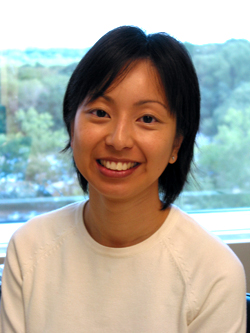
|
|
Peggy Hall, Biological Technician, Sequencing Production Technician, National Intramural Sequencing Center, National Human Genome Research Institute, National Institutes of Health
|
Biological TechnicianMeet a real Biological Technician, Peggy Hall
1. I chose this career because...
2. My typical workday involves...
3. What I like best/least about my work...
4. My career goals are...
5. When I'm not working, I like to...
|
|
1. I chose this career because...
|
Back to Top

|
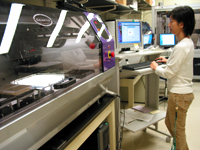
|
|
Peggy sets-up the QPix, an automated colony-picking robot.
|
I choose to become a biological technician by accident. In high school, I did not do that well in biology. When I went to college, I was thinking of nursing as a major. After taking biology in college, I was doing better and liked the course. At the same time, I was volunteering in a hospital as a nursing-clerical assistant. With time, I realized that I didn’t like the environment. It just didn’t fit my personality. The definitive moment came one night when a lady came up to me and just kept repeating the word “help.” I didn’t know what to do. I couldn’t help her. It was an upsetting moment. That’s when I decided to choose biology as a major. I was performing well in my science classes and my interest in biology kept growing.
College Education
Bachelor of Science, Biology, University of Maryland (http://www.umd.edu/), College Park, Maryland
|
|
2. My typical workday involves...
|
Back to Top

|
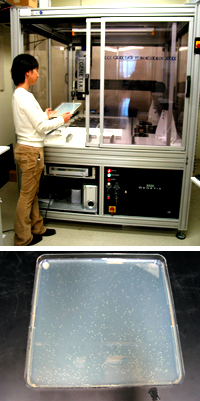
|
|
Peggy uses the QBot robot (top) to pick a large number of colonies growing on agar plates (bottom).
|
My typical workday involves constructing a deoxribonucleic acid (or DNA) library. It is a way of taking a long string of DNA and breaking it up into small pieces (a library), which we can study further. This is just one step in a series of steps to do large scale DNA sequencing. In our section of the National Intramural Sequencing Center (NISC), we receive DNA samples in a glycerol stock from different sources.
My sequence of tasks is to:
- Breakup (or physically shear) the DNA into random little pieces
- Set up a robot that picks the colonies and inserts them into a small amount of media
Robots (from Genetix, http://www.genetix.com/xhtml/about.aspx) I Use in my work are:
- QBot – a colony-picking machine that can manipulate a large number of samples in 384-well plates much faster than a human. It can do a few other specialized functions as well.
- QPix – a colony picker that can manipulate only one plate at a time
Special Projects
On occasion, I do special projects as requested. For example, if the “finishers” (people who review the final sequence) see an area in the sequence that is blank or incomplete, they will ask me to repeat the process using a different vector. Sometimes that will work and the second sequencing attempt will be successful.
|
|
3. What I like best/least about my work...
|
Back to Top

|
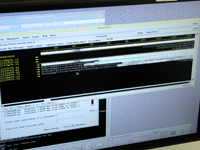
|
|
Peggy analyzes the DNA sequences using a software program that makes it easy to spot the areas where the sequence is incomplete.
|
What I like best about my work is the way we rotate to different areas in the sequencing center. You get to learn new skills and the work doesn’t get boring or routine. My favorite work was the computer analysis I did when I was in the finishing section. We have a software program to analyze the DNA sequences. I reviewed the sequence data to make sure it was complete. If the sequence was not good, I suggested methods to use to improve that sequence area.
What I like least about my work is watching the robot machine pick the colonies. The robot does the work, but I must make sure that it is picking individual colonies and that no cross-contamination occurs. It works well, but not 100%. If there is a problem, I must check the robot alignment and follow problem-shooting protocols.
|
|
4. My career goals are...
|
Back to Top

|
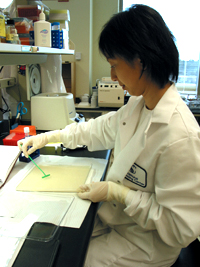
|
|
Peggy spreads a culture of cells on agar plates and places them in the incubator to grow until colonies appear.
|
My career goals are to continue learning a lot more lab techniques. I also want to know more about the background and current research within the Human Genome Project.
|
|
5. When I'm not working, I like to...
|
Back to Top

|
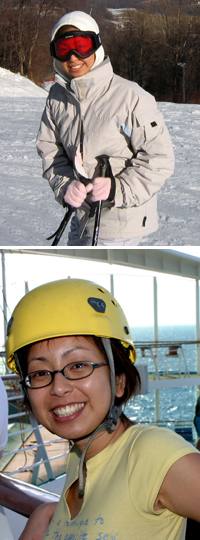
|
|
Peggy enjoys a winter ski trip (top) and did a little wall climbing on a cruise ship during a recent vacation (bottom).
|
When I’m not working, I like to ski in winter. I usually ski at the nearest slopes in Pennsylvania. I like swimming year round, but especially in the summer. I also enjoy taking vacations every year to different countries. In recent years, I’ve traveled to Asia, Hong Kong and Singapore, and went on a Caribbean cruise.
|
|
|
|
 |